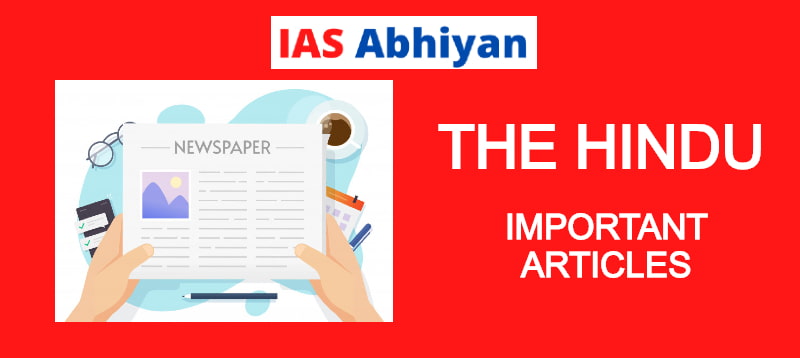IAS Abhiyan Present’s The Hindu Important Articles for UPSC: 28th September 2020
An Initiative to provide all the important The Hindu Important Articles to be followed / read. This initiative will cover section / paper wise important The Hindu Important Articles as per UPSC CSE Syllabus to enable all the aspirants to identify the important article (s) to read / make notes. All the compilations of The Hindu Important Articles will be covered in our Monthly Pre-Bits Flash Liner-One Liner Current Affairs & Monthly Current Affairs Digest (CAD).
Click here for The Hindu Important Articles: Archives
IAS Abhiyan Current Affairs Course for Prelims-2021 is now available only @149/-. Click here to Know
IAS Abhiyan Advance Learning Programme (ALP)-2021 is available now @499/- (Offer for limited Period). Click here to Know
Constitution, Polity & Governance-GS Paper 2
- Tense LAC makes Ladakhi team call off election boycott
- Where is the sentinel guarding our rights?
- Diagnosing what ails medical education
International Relations-GS Paper 2
- India, Japan navies match skills in northern Arabian Sea
- Clashes erupt between Armenia, Azerbaijan
- Mahinda statement on Modi meet silent on 13-A
Economic Development- GS Paper 3
- Growth compulsions, fiscal arithmetic
- Salutary lesson
- Farmers can now break free of APMC shackles, says PM
Science and Technology- GS Paper 3
Biodiversity and Environment- GS Paper 3
Visit Abhiyan PEDIA (One of the Most Followed / Recommended) for UPSC Revisions: Click Here
Note: Other Important Topics will be added to our Abhiyan PEDIA after UPSC Prelims-2020
Quick Revision for Prelims-Daily Dose
- As per the Bio-diversity Act of 2002, it is the State government’s responsibility to identify places of importance in terms of bio-diversity and declare them heritage sites.
- Gharats are water-powered grinding mills found in Himalayan villages. Though these are owned and managed by individuals, they are considered to be the common property of the entire village.
- Dr. Ambedkar established different types of organisations to lead these movements. In all these were six as given below.(1) Bahiskrit Hitkarini Sabha (1924)
(2) Samaj Samata Sangh (1927)
(3) Samata Sainik Dal (1928)
(4) Independent Labour Party (1936)
(5) All India Scheduled Castes Federation (1942)
(6) Republican Party of India (1956)Note: Of these six organizations, first, two were mainly of social
service type, third was a volunteer organization and demanding three were political parties. - The Migratory Species Champion Programme initiatives developed under the Convention of Migratory Species (CMS) family and encourage their sustainable support. India is to join the ranks of CMS Champions at the event for the first time.
- The Asia Cooperation Dialogue (ACD)- An intergovernmental organization created on 18 June 2002 to promote Asian cooperation at a continental level. Help integrate separate regional organizations such as the ASEAN, the Gulf Cooperation Council, the Eurasian Economic Union, the Shanghai Cooperation Organisation, and the SAARC.
- BreatheLife is a joint campaign led by the World Health Organization (WHO), United Nations Environment and the Climate & Clean Air Coalition (CCAC) to mobilize cities and individuals to protect our health and planet from the effects of air pollution.
- Blue holes-Marine caverns filled with water and are formed following dissolution of carbonate rocks, usually under the influence of global sea level rise or fall. They are isolated from the ocean and don’t receive fresh rainwater. Generally circular, steep-walled and open to surface. In News: Carbon more than 8,000 years old has been found inside the world’s deepest blue hole — the Yongle Blue Hole (YBH) — which was recently discovered in the South China Sea. Far deeper than the previously recorded deepest blue hole, Dean’s Blue Hole in Bahamas.
- India and Portugal inaugurated a Cha-Chai art-work installation at the National Museum. Depicted the bridge between rural and urban landscape.
- Kottichetham-An excerpt from the Tamil epic Silappathikaram, written by Ilango Adigal. Believed to have been danced by the Parayur Chakyan of the Chera court for the King and the queen. Dance of Lord Siva and Uma.


